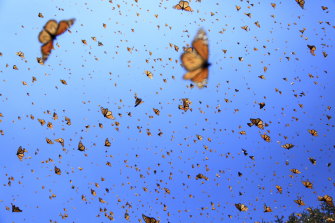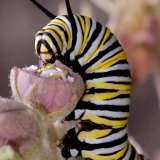Washington: The monarch butterfly has fluttered a step closer to extinction, after scientists put the iconic orange-and-black insect on the endangered list because of its fast dwindling numbers.
“It’s just a devastating decline,” said Stuart Pimm, an ecologist at Duke University who was not involved in the new listing. “This is one of the most recognisable butterflies in the world.”
The International Union for the Conservation of Nature added the migrating monarch butterfly for the first time to its “red list” of threatened species and categorised it as “endangered” — two steps from extinct.
The flight of the monarchs.Credit:File
The group estimates that the population of monarch butterflies in North America has declined between 22 per cent and 72 per cent over 10 years, depending on the measurement method.
“What we’re worried about is the rate of decline,” said Nick Haddad, a conservation biologist at Michigan State University. “It’s very easy to imagine how very quickly this butterfly could become even more imperilled.”
The butterflies are very common in Australia. According to the Foundation for National Parks & Wildlife, they arrived in Australia from North America as recently as 1871. Once its host plant, the milkweed of the genus Asclepias, arrived as well, the butterflies began to flourish.
Monarch butterflies cluster together at the Monarch Butterfly Sanctuary in Pacific Grove, California.Credit:Melina Mara/The Washington Post
Haddad, who was not directly involved in the listing, estimates that the population of monarch butterflies he studies in the eastern United States has declined between 85 per cent and 95 per cent since the 1990s.
In North America, millions of monarch butterflies undertake the longest migration of any insect species known to science.
After wintering in the mountains of central Mexico, the butterflies migrate to the north, breeding multiple generations along the way for thousands of miles. The offspring that reach southern Canada then begin the trip back to Mexico at the end of summer.
A monarch caterpillar feeds on a milkweed plant along a walking trail in Great Falls, Montana, US.Credit:AP/File
“It’s a true spectacle and incites such awe,” said Anna Walker, a conservation biologist at New Mexico BioPark Society, who was involved in determining the new listing.
A smaller group spends winters in coastal California, then disperses in spring and summer across several states west of the Rocky Mountains. This population has seen an even more precipitous decline than the eastern monarchs, although there was a small bounce back last northern winter.
Emma Pelton of the non-profit Xerces Society, which monitors the western butterflies, said the butterflies are imperilled by loss of habitat and increased use of herbicides and pesticides for agriculture, as well as climate change.
“There are things people can do to help,” she said, including planting milkweed, a plant that the caterpillars depend upon.
Non-migratory monarch butterflies in Central and South America were not designated as endangered.
The United States has not listed monarch butterflies under its Endangered Species Act, but several environmental groups believe it should be listed.
The international union also announced new estimates for the global population of tigers, which are 40 per cent higher than the most recent estimates from 2015.
The International Union for the Conservation of Nature announced new tiger global population estimates are 40 per cent higher than the most recent estimates from 2015.Credit:AP
The new figures, of between 3726 and 5578 wild tigers worldwide, reflect better methods for counting tigers and, potentially, an increase in their overall numbers, said Dale Miquelle, coordinator for the non-profit Wildlife Conservation Society’s tiger program.
In the past decade, tiger populations have increased in Nepal, northern China and perhaps in India, while tigers have disappeared entirely from Cambodia, Laos and Vietnam, said Miquelle. They remain designated as endangered.
AP
Most Viewed in World
From our partners
Source: Read Full Article




